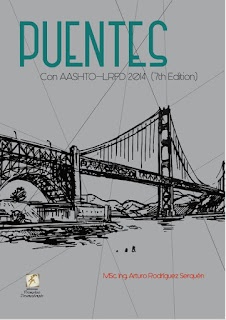Tips Ingenieria Civil
Alcances a la carrera de Ingeniería Civil; con el fin de ayudar a entender conceptos que se van dando a lo largo de esta hermosa carrera.
jueves, 9 de agosto de 2018
jueves, 12 de julio de 2018
by T. Bart Quimby, P.E., Ph.D., F.ASCE
The material presented here is free to be used for educational purposes. The work is copyrighted and all rights are reserved by the author. The author reserves the sole right to profit from this material. It may be printed, copied, stored electronically, or otherwise distributed as long as proper credit is given to the author and there is no charge to anyone for the material. While we try to be as accurate as possible, there is no warranty that the material here is accurate or correct. Use the information provided here at your own risk.
Real structures or parts of structures and typical engineering drawings are used in these works as much as possible so that the student can transition into the practice of structural engineering with a minimum of challenge.
lunes, 19 de marzo de 2018
ANÁLISIS Y DISEÑO DE PUENTES DE CONCRETO ARMADO Ing. César Aranis García-Rossell
Tabla de
Contenidos.
INDICE
I. Puentes
II. Puentes
de concreto armado
III.
Estribos
IV. Pilares
y columnas
V. Apoyo de
puentes
VI. Diseño
sismorresistente
Anexo.
01.lineas de
influencia
02.
Hidráulica de puentes
Bibliografía
Diseño de Puentes de Tipo Viga-Losa Metodo AASHTO LRFD y consideraciones Hidrológicas,Hidráulicas y Geotécnicas
Contenido
1.1 Definiciones y Conceptos
1.2 Filosofía de Diseño AASHTO: ASD y LRFD
1.3 Estudios básicos de Ingeniería de Detalle
1.3.1. Estudios Topográficos
1.3.1.1 Relleno, Niveles y Seccionamientos
1.3.2 Estudios hidrológicos
1.3.2.1 Caudal máximo de Diseño y nivel NAME.
1.3.3 Estudios Hidráulicos
1.3.3.1 El Fenómeno de la Erosión y Socavación
1.3.3.2 Profundidad de Socavación.
1.3.3.3 El Fenómeno de Tubificación.
1.3.3.4 El Fenómeno de la Migración Lateral de río.
1.3.2.1 Caudal máximo de Diseño y nivel NAME.
1.3.3 Estudios Hidráulicos
1.3.3.1 El Fenómeno de la Erosión y Socavación
1.3.3.2 Profundidad de Socavación.
1.3.3.3 El Fenómeno de Tubificación.
1.3.3.4 El Fenómeno de la Migración Lateral de río.
1.3.4 Estudios geológicos y geotécnicos
1.3.4.1 Ensayos de campo y laboratorio
1.3.4.2 Clasificación de suelos
1.3.4.3 Tipos de fallas en la cimentación
1.3.4.4 Capacidad Portante del Terreno
1.3.4.1 Ensayos de campo y laboratorio
1.3.4.2 Clasificación de suelos
1.3.4.3 Tipos de fallas en la cimentación
1.3.4.4 Capacidad Portante del Terreno
1.3.5 Estudio de Riesgo Sísmico
1.3.6 Estudios de Tráfico
1.3.7 Trazo y diseño Vial de Accesos.
1.3.8. Estudios de Impacto Ambiental
1.3.9. Estudios complementarios
1.3.6 Estudios de Tráfico
1.3.7 Trazo y diseño Vial de Accesos.
1.3.8. Estudios de Impacto Ambiental
1.3.9. Estudios complementarios
1.4 Diseño de puentes método AASHTO LRFD
1.4.1 Cargas y Fuerzas externas (sismos)
1.4.2 Estados limites y Factores de carga
1.4.3 Factores y Combinaciones de Estados de carga
1.4.1 Cargas y Fuerzas externas (sismos)
1.4.2 Estados limites y Factores de carga
1.4.3 Factores y Combinaciones de Estados de carga
1.5 Diseño de la subestructura
1.5.1 Diseño de cajuelas o dispositivos de apoyo
1.5.2 Diseño de estribos y pilares
1.6 Líneas de influencia
1.5.1 Diseño de cajuelas o dispositivos de apoyo
1.5.2 Diseño de estribos y pilares
1.6 Líneas de influencia
1.7 Análisis y Cálculos
1.7.1 Análisis comparativo de Momentos y Cortantes últimos en vigas de puente de 25m de doble vía y con 4 vigas de apoyo con el CSI Bridge y el método AASHTO LRFD teórico.
1.7.2 Análisis y Diseño completo de un puente
viga–losa de 20 m simplemente apoyado y de
una sola vía con la hoja de calculo PUENCAR
versión X
1.7.1 Análisis comparativo de Momentos y Cortantes últimos en vigas de puente de 25m de doble vía y con 4 vigas de apoyo con el CSI Bridge y el método AASHTO LRFD teórico.
1.7.2 Análisis y Diseño completo de un puente
viga–losa de 20 m simplemente apoyado y de
una sola vía con la hoja de calculo PUENCAR
versión X
PUENTES Con AASHTO-LRFD 2014 ing Arturo Rodríguez Serquén
Contenido:
- Consideraciones generales
- Cargas
- Superestructuras de puentes
- Dispositivos de apoyo
- Estribos
- Pilares
- Lineas de influencia
Suscribirse a:
Entradas (Atom)
LIBROS DE APOYO SOBRE EL TEMA DE PUENTES 1.Bridge.Engineering.Handbook.Fundamentals 2.Bridge.Engineering.Handbook.Super.Structure...

-
AMERICAN INSTITUTE OF STEEL CONSTRUCTION En este archivo encontraras las guías AISC para el diseño de acero estructural, tenemos: ...
-
Es una pagina muy bueno con información de excelente calidad sobre estructuras, geotecnia, mecánica de suelos y de rocas, entre otras mas, ...
-
Tabla de Contenidos. INDICE I. Puentes II. Puentes de concreto armado III. Estribos IV. Pilares y columnas V. Apoyo de...










